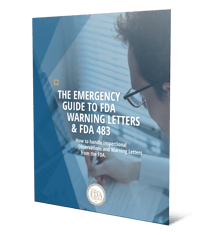 To Quality Assurance professionals in the pharmaceutical industry, Quality Risk Management (QRM) is a process attributed to a specific action: Assessing quality risks to a drug across its lifecycle.
To Quality Assurance professionals in the pharmaceutical industry, Quality Risk Management (QRM) is a process attributed to a specific action: Assessing quality risks to a drug across its lifecycle.
But the value of QRM isn't pinned to a narrow set of product quality risks, nor does it have to be the long and arduous process it's often thought as. As an adaptable review framework, it can be applied in differing degrees to a number of situations where risk management plays a major role in the decision-making process.
The FDA makes this point clear throughout ICH Q9 as a guiding principle of QRM in general:
“the degree of rigor and formality of quality risk management should reflect available knowledge and be commensurate with the complexity and/or criticality of the issue to be addressed.”
Viewing QRM as a framework that can be applied in varying degrees to all areas that pose possible risks to product safety, it can become a valuable tool in cultivating a culture of quality throughout your organization by enabling risks to be assessed, reviewed, and rated as a natural reaction to all quality issues that arise.
Applying Quality Risk Management (QRM) to Daily Operations
While Failure Mode Effects Analysis (FMEA) is the QRM model used most frequently, FDA presents a number of other areas QRM can be applied in the "Risk Management Methods and Tools" section of ICH Q9. These include:
In the FMEA method, risks are assigned scores based upon their severity and the probability they might occur. Deviations are given their own lines, and scores are determined based on potential failure modes, failure mechanisms, and their overall impact on the operation of the system.
Scales and ranges indicating low, medium, or high risk are set so the appropriate next actions can be taken based on priority.
When applied to other daily operations, this general framework offers a method for developing risk-based mindsets throughout the company.
This approach offers three major advantages:
- A standardized approach to maintaining compliance throughout the organization
- Greater ability to prevent adverse effects by detecting product issues earlier
- Faster, easier identification of critical vs. non-critical deviations
Tackling Misconceptions Around QRM
Contrary to what many think, conducting a risk assessment for a deviation does not always involve tedious analysis and paperwork. What's more, the FDA does not expect formal risk assessments be carried out for all issues encountered. According to ICH Q9,
“It is neither always appropriate nor always necessary to use a formal risk management process (using recognized tools and/or internal procedures, e.g., standard operating procedures). The use of informal risk management processes (using empirical tools and/or internal procedures) can also be considered acceptable.”
When a formal assessment is necessary, it does not need to be the grueling task it's often thought as. By tackling the potential impacts of a deviation as a group using a FMEA matrix, not only do assessments take less time, they also offer an opportunity for individuals from across the organization to come together as a cross-functional group in order to gain new perspectives and understand risks at a deeper level.
Free white paper: The Emergency Guide to FDA Warning Letters & FDA 483
When taking this approach, it's important to ensure the group you assemble represents all departments at risk of being impacted by the change. Ideally, each area should be represented by a management-level individual as well as a lower-level team member who can offer a different perspective.
Using QRM to Cultivate a Culture of Quality
In addition to the specific advantages already mentioned, QRM more generally helps to enhance interdepartmental relationships and problem-solving skills by creating a shared expectation throughout the organization. Without it, stakeholders within the company can remain siloed and unable to accurately assess the impact of a risk through the eyes of someone else.
This culture of quality does not go unnoticed by regulators, either. Demonstrating a shared understanding and ability to work through possible risks together signals your ability to maintain quality throughout a product's lifecycle.
Adapting QRM to daily operations cultivates a culture that values quality as a primary consideration when any decision is made. It arms employees with the tools and processes for making better decisions faster.
By using QRM, employees understand the impacts of risks not only as they apply to their area of work, but to the company as a whole — a mindset that that improves outcomes throughout the organization.



